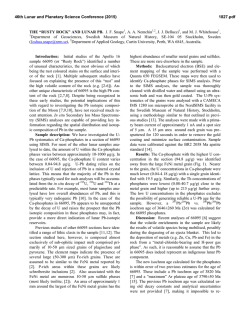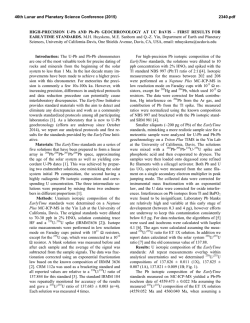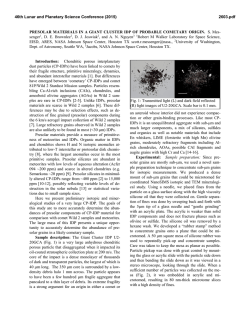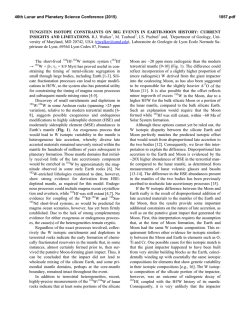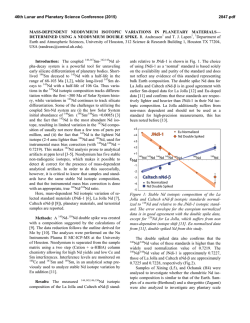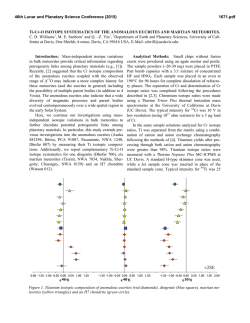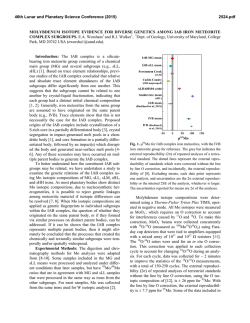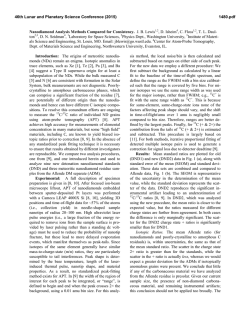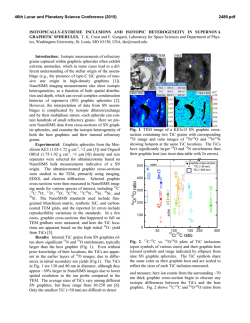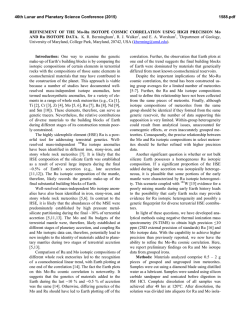
A coherent Pb isotopic model for ALH84001 and some enriched
46th Lunar and Planetary Science Conference (2015) 1761.pdf A coherent Pb isotopic model for ALH84001 and some enriched Shergottites. J. J. Bellucci1*, A. A. Nemchin, J. F. Snape, R.B. Kielman, and M.J. Whitehouse, 1Department of Geosciences, Swedish Museum of Natural History, SE-104 05. *Corresponding Author’s email: [email protected] Introduction: Establishing geochemical relationships between Martian metetorites will allow for the construction of coherent models of Martian reservoir formation. Currently, there are five known types of Martian meteorites: Shergottites, Nakhlites, Chassignites (SNCs), ALH84001 (an orthopyroxenite), and NWA7533 (a regolith breccia). ALH84001 is a unique orthopyroxenite that has a Lu-Hf crystallization age of 4.091±0.030 Ga (2σ [2]). The SNCs are comprised of mafic and ultramafic rocks with a relatively limited compositional range and Rb-Sr, Sm-Nd, and Lu-Hf ages (0.16-1.3 Ga, e.g., [1]). The enriched Shergottites generally have a younger age (~170 Ma) than the depleted Shergottites (~500 Ma) (e.g., [3,4,5]). The source reservoir for the Shergottites and ALH84001 likely formed at 4.513 Ga based on the combined isotopic systematics of Lu-Hf and Sm-Nd [2]. To date, similar approaches to understanding Martian reservoir formation utilizing the Pb isotopic system have been difficult. This is largely due to contradicting interpretations of Pb isotopic data in the literature. Steep arrays in 207Pb/204Pb vs. 206Pb/204Pb are observed in almost every Martian meteorite. Steep arrays in Pb isotopic data have been interpreted either as mixing trends between Pb formed by the in situ decay of U or residence of the samples on the Earth’s surface and/or laboratory handling (e.g., [3-7]). If the steep arrays are due to closed system U-decay then the Shergottites have a crystallization age of >4 Ga [6,7]. However, if there is unsupported radiogenic Pb in the samples then any age calculations in these arrays are invalid. Regardless of the origin of the steep trends in Pb isotopic data, the initial Pb in all of these meteorites should enable construction of a coherent, time-integrated Martian Pb isotopic model. Solution chemistry and laboratory procedures can introduce unwanted radiogenic Pb via handling or terrestrial contamination. Additionally, minerals that contain heterogeneous Pb isotopic compositions, small amounts of U, or grain boundary alteration that will accumulate radiogenic Pb over time will be homogenized during solution analyses and not yield the true initial Pb. Feldspars, specifically in this case shocked plagioclase (maskelynite), contain relatively abundant Pb and very little or no U. Therefore, these grains should contain true initial Martian Pb. Secondary Ion Mass Spectrometry (SIMS) offers an in situ technique that minimizes contamination, can target the middle of crystals, and can yield large, statistically significant data sets. As such, the aim of this study is to determine the true, initial Pb isotopic composition of ALH84001 and three enriched Shergottites (Zagami, RBT04281, LAR12011) via SIMS and model the UTh-Pb evolution of each source, explore possible reservoir relationships, and determine if a Martian Pb isotopic model can be used to determine ages for these meteorites that are in agreement with all other radiogenic isotopic systems. Analytical Methods: The Pb isotopic compositions of maskelynite were determined using Secondary Ion Mass Spectrometry on a polished epoxy mounts or thin sections of each sample. Before analysis, each sample was cleaned in alternating 1-minute baths of water and ethanol. After thorough washing, a 30 nm coating of Au was applied to the surface. All measurements were conducted using a CAMECA IMS1280 instrument at the Swedish Museum of Natural History, Stockholm (NordSIM facility) using the experimental protocol from [8]. An area of 35x35 µm was rastered for 70 s prior to Pb isotopic analysis to eliminate surface contamination. A 300 µm aperture was used resulting in a 12-15 nA O2- primary beam with a 30 µm slightly elliptical spot on the surface of the sample. Mass resolution during all analyses was 4860 (M/ΔM). All analyses were conducted in multi-collector mode using an NMR field sensor in regulation mode to control the stability of the magnetic field. Lead isotopic ratios were measured in low noise (<0.01 cps) ioncounting electron multipliers for 160 cycles with a count time of 10 s, resulting in a total collection time of 1600 s. Isotopic ratios were calculated using integrated means for all analyses. Mass fractionation and gain calibrations between detectors were performed by bracketing the unknowns with analyses of USGS basaltic glass reference material BCR-2G. Corrections to the unknown measurements were performed using values from [9] and a linear gain calibration. External reproducibility in 208Pb/206Pb and 207Pb/206Pb was 0.3% (2σ) and in 208Pb/204Pb, 207Pb/204Pb, and 206Pb/204Pb was 0.90%, 0.7%, and 1% (2σ, respectively). Results: Initial Pb compositions for each Martian meteorite were determined by taking the least radiogenic population of Pb isotopic data measured in maskelynite and performing an X-Y weighted mean calculation. This approach allows for the determination of the initial Pb isotopic compositions for a statistically identical population. Calculations were performed using ISOPLOT 4.15 for 207Pb/204Pb vs. 206Pb/204Pb and were attempted for 208Pb/204Pb vs. 206Pb/204Pb. There was a larger spread in 208Pb/204Pb in ALH84001 and 46th Lunar and Planetary Science Conference (2015) (Fig 1). Zagami has a calculated µ value of 4.1 and RBT04262 and LAR12011 have almost identical initial Pb isotopic compositions and come from a source with a µ-value of 4.6. Both of these µ-values have growth curves that intersect the initial Pb isotopic composition of ALH84001 (Fig 1). A κ-value of 3.4 is within error of all initial Pb measurements, although ALH84001 may have an initial κ-value that is less than the enriched Shergottites (Fig 1). An increase from 14.5 in µ-value is possible with the precipitation of sulfides during silicate differentiation [5]. Therefore, it is feasible that the silicate differentiation event that produced the source reservoir for ALH84001 and the enriched Shergottites also precipitated sulfides at 4.513 Ga. The reservoir that produced ALH84001 and the enriched Shergottites has remained unmixed from 4.1 Ga-0.17 Ga, consistent with the presumed lack of mantle convection on Mars. Lastly, using the Pb isotopic model presented here, initial Pb model ages for ALH84001 and the enriched Shergottites are determined as ~4.1 Ga and ~0.17 Ga, respectively. This results challenges the ancient (> 4 Ga) Pb-Pb isochron ages reported for the Shergottites. 35 208 Pb/ 204 Pb 34 x RBT04281 LAR12011 Zagami ALH84001 Initial Pb at 4.51 Ga 33 32 κ=3.4 31 30 h x gr ow t 13.5 Ga Pb μ=4.1 51 -4 .1 12.5 12 4. 204 Pb/ μ=4.6 Pb 13 207 LAR12011, so an X-Y mean could not be calculated for 208Pb/204Pb vs. 206Pb/204Pb. Instead, the 208Pb/204Pb values corresponding to the analyses used in the X-Y 207 Pb/204Pb vs. 206Pb/204Pb weighted mean calculations were used in a one-dimensional weighted mean calculation. In addition to determining the initial Pb isotopic composition of ALH84001, the Pb isotopic compositions for orthopyroxene grains were also measured. The spread in the data was enough to yield a feldsparpyroxene isochron with an age of 4.093±0.066 Ga (2σ). This age is identical, within error to the 4.091±0.030 Ga determined by Lu-Hf [2] and a previously determined Pb-Pb isochron age of 4.074 ± 0.099 Ga [7]. Pyroxenes were also measured in each of the enriched Shergottites but the uncertanties were too large for meaningful calculations to be made. Discussion: The initial Pb composition for ALH84001 is significantly less radiogenic than that implied by the solution measurements of [7] and lies close to the 4.1 Ga Geochron. The Pb isotopic composition of the orthopyroxene measured here is significantly less radiogenic than the residue analyses of successive orthopyroxene leachates reported by [7] (206Pb/204Pb of 18.8 vs. 73.8). This discrepancy implies that there is a previously undocumented U-bearing phase in ALH84001 that was incorporated into the material analyzed via traditional solution methods. Despite being the least radiogenic Pb measured in all of the Martian meteorites so far, the initial Pb determined for each sample lies to the right of the Geochron corresponding to the ages determined by Sm-Nd, Rb-Sr, and Lu-Hf for all samples. This explicitly implies at least a two-stage differentiation history and/or mixing with a more evolved end member. Simlar observations have been made on Earth for crustal rocks and despite multiple differentiation events or mixing, a reasonably successful Pb isotopic model has been constructed [10]. The formation of the source reservoir for ALH84001 and the Shergottites happened at 4.513 Ga from a chondritic reservoir, based on coupled Lu-Hf and Sm-Nd systematics [2]. If a similar approach is taken here and the U-Th-Pb isotopic system on Mars began with initial solar system Pb (Canyon Diablo Troilite) and evolved with a chondritic µ (238U/204Pb) of 1, from 4.567 Ga to 4.513 Ga, this value would represent the source reservoir Pb isotopic composition at 4.513 Ga. Pb evolution lines with the slope corresponding to the ages of each sample and the source reservoir Pb composition at 4.513-sample age, determined by Sm-Nd/Lu-Hf/Rb-Sr are shown in Fig 1. All initial Pb compositions now lie on Pb growth lines corresponding to ages determined by external methods. As the measured initial compositions now lie on a Pb growth line corresponding to their crystallization age, both µ- and κ(232Th/238U)- values can be calculated 1761.pdf 11.5 10.5 10 9 7 0.1 1- 4.5 11 Pb Ga ow gr th x Error elipses 2σ 10 11 12 206 Pb/ 13 204 14 15 Pb Figure 1. Initial Pb isotopic comopsitions of ALH84001 and 3 enriched Shergottites. References: [1] Nyquist et al., (2001) Space Sci. Rev. 96, 105– 164. [2] Lapen et al., (2010) Science 328, 347-351. [3] Borg et al., (2003) GCA 67, 3519-3536 [4] Borg et al., (2005) GCA 69, 58195830. [5] Gaffney et al., (2007) GCA 71, 5016-5031 [6] Bouvier et al., (2008) EPSL 266, 105-124. [7] Bouvier et al., (2009) EPSL 280, 285-295. [8] Bellucci et al., (2015) EPSL 410, 34-41. [9] Woodhead and Hergt (2000) GGR 24, 33-38. [10] Stacey and Kramers (1975) EPSL 26, 207-221.
© Copyright 2026
